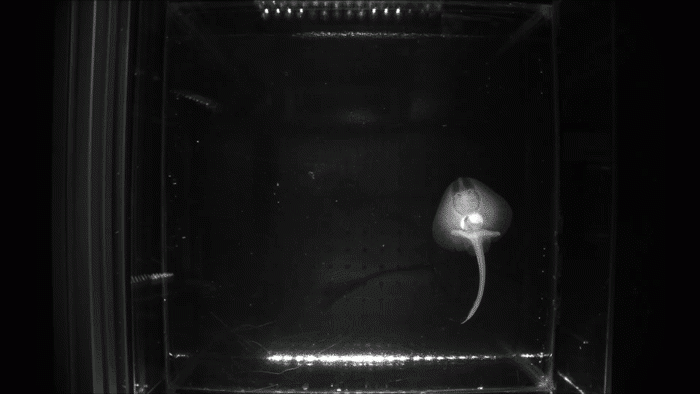News
Researchers from New York University found that little skates, which scuttle along the sea floor on two leg-like fins, use the same motor neurons and genes that help humans and other land vertebrates walk. (Video courtesy of Jung et al./N.Y.U. School of Medicine)
In 2018, the little skate, a ray-like fish the size of a skillet, caused a big wave in evolutionary biology. Researchers from New York University found that little skates, which scuttle along the sea floor on two leg-like fins, use the same motor neurons and genes that help humans and other land vertebrates walk.
The findings suggested that the neural networks required for walking might already have been present in the common ancestor of skates and mammals about 420 million years ago — millions of years before the first intrepid fish crawled out of the ocean.
But how exactly did our ancient aquatic ancestors walk? While the fossil record preserves their bones, the neuromuscular system and pathways that controlled their movement are lost.
That’s where theoretical models can help illuminate the range and difficulty of different strategies.
Researchers from the Harvard John A. Paulson School of Engineering and Applied Sciences (SEAS) developed a mathematical framework to explain how underwater walking may have evolved. The researchers found that the ancient ancestors of skates and humans could have achieved efficient underwater walking using the available body morphology with very little energy and simple controls.
The research was published in the journal Royal Society Interface.
The researchers showed that the left-right alternating gait used by skates and other vertebrates arises with a simple algorithm based on reinforcement learning, consistent with a simple theoretical model. To test the framework, the researchers built a bipedal robot and showed that its behaviors are similar to those in the model.
“Our research is another piece in the puzzle towards understanding the evolution of legged locomotion,” said Fabio Giardina, a Postdoctoral Fellow in Applied Mathematics at SEAS and first author of the paper. “We showed that given a rudimentary morphology, there are simple control laws that will lead to very efficient locomotion. The physics is giving us everything we need for walking to be feasible underwater.”
“The combination of a reliable low gravity environment and a legged-body morphology may well have helped pave the way for bipedal gaits before our aquatic ancestors transitioned to terra firma,” said L. Mahadevan, the Lola England de Valpine Professor of Applied Mathematics, of Organismic and Evolutionary Biology, and of Physics and senior author of the paper. “As our ancient ancestors transitioned to land, the control strategy likely became more complex. But in reliably homogeneous environments, like the sea floor, perhaps a simple strategy was all that was needed.”
In addition to shedding light on the past, this research paves the way for designing more efficient bioinspired robots in the future.
“In addition to energy efficient locomotion, we found that our robot can recover from large disturbances without actively correcting them, a property we attribute to the adaptation of the design to the physical environment,” said Giardina. “We believe that this approach will help us build more efficient and robust walking robots in the future.”
“Our work adds to the increasing evidence that to truly understand behavior or synthesize it using robots, we need to consider the interaction between the brain, the body and environment,” said Mahadevan.
This research was supported in part by Swiss National Science foundation (Grant P400P2-191115) and by a MacArthur Fellowship.
Topics: Applied Mathematics
Cutting-edge science delivered direct to your inbox.
Join the Harvard SEAS mailing list.
Scientist Profiles
L Mahadevan
Lola England de Valpine Professor of Applied Mathematics, of Organismic and Evolutionary Biology, and of Physics
Press Contact
Leah Burrows | 617-496-1351 | lburrows@seas.harvard.edu




